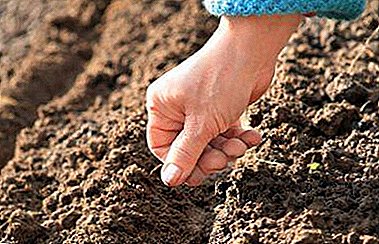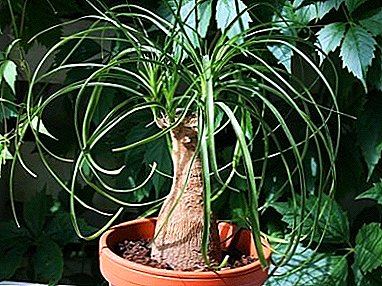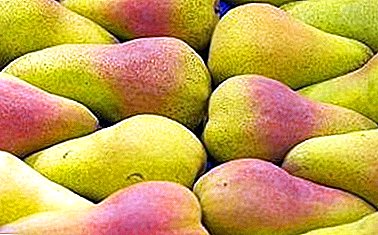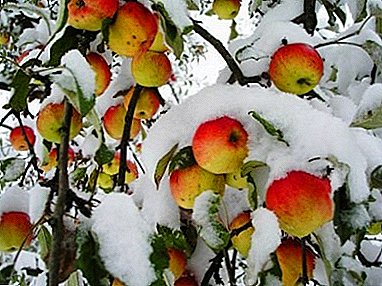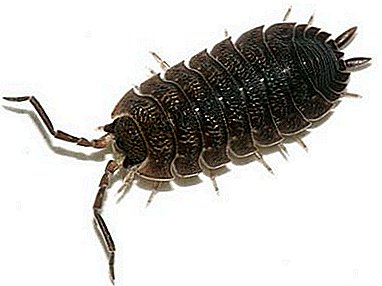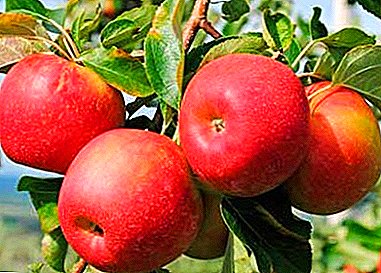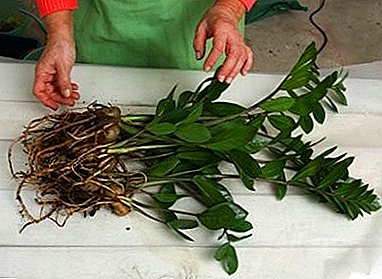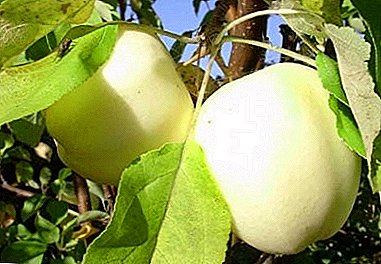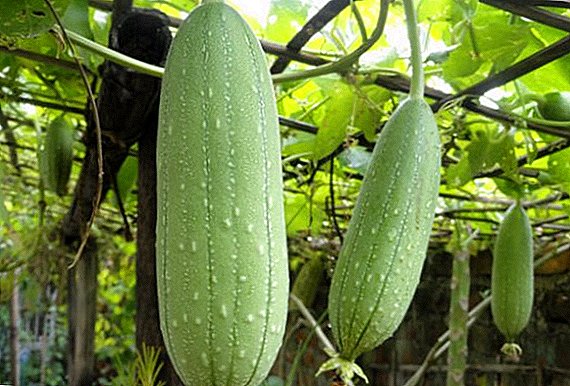 Different plants have different properties that are beneficial to humans, and if some of them are used only for culinary or decorative purposes, others can serve in everyday life. The latter includes loofah, known as a good raw material for the manufacture of bath sponges.
Different plants have different properties that are beneficial to humans, and if some of them are used only for culinary or decorative purposes, others can serve in everyday life. The latter includes loofah, known as a good raw material for the manufacture of bath sponges.
Botanical description
Lyufa is a representative of liana plants, with shoots up to 4-7 m in length. All of them have branched antennae and rough edges. Leaves - palmate-five-lobed (sometimes whole) and arranged alternately.
In outline, the leaf plates resemble a heart with a diameter of 15-27 cm and teeth located along the edges. All of them evaporate a lot of moisture, so the plant needs regular watering.
Pretty large loofah flowers - monoecious, dioecious, painted white or yellow.
Staminate varieties are collected in racemes, while pistillate varieties are distinguished by a single arrangement. Flowering plants can be observed from June.  The green corrugated fruits of the plant resemble spindle-shaped "cucumbers", whose length is about 50 cm, with a diameter of 7-12 cm. Immediately after ripening, they begin to dry, and sclerenchymal fibers develop in them.
The green corrugated fruits of the plant resemble spindle-shaped "cucumbers", whose length is about 50 cm, with a diameter of 7-12 cm. Immediately after ripening, they begin to dry, and sclerenchymal fibers develop in them.
Seeds of such "cucumbers" have an ovoid shape and marginal bordering. Seed length can reach up to 1.2 cm. Full ripening of fruits is noted towards the end of summer.
The rhizome of the vines is weak and is located in the surface layer of the soil.
Did you know? The described plant has many interesting names and, in addition to the "loofah", the vine is often called the Vietnamese pumpkin, Chinese okra, urinal pumpkin and even rabid cucumber.
Kinds
Today, there are about fifty kinds of loofah, however, only two of them are used for growing in the garden: ostrorebristaya and cylindrical, and it is from the latter that the popular loofes are made.
Spiky
This species is represented by an annual liana, reaching a length of 3-6 meters. Pentahedral stems have rough edges on the ribs and are fixed to the support with the help of branched tendrils.
Sheet plates reach 20 cm in diameter, in most cases they are 5-7-coal or divided into several separate blades.
The fastening of the leaves to the stalk is carried out by means of rather long petioles - about 8-12 cm each.
All the flowers of the plant are heterosexual and can have five 2 cm pale yellow petals each. Stamen species form racemes, 17–20 each, and pistillate ones are solitary and are located in the axils of the same leaves as the staminate ones.
The fruits of the ostrekobristoy loofah have a club-shaped form and reach half a meter long, with a diameter of 6-10 cm.  The taste of young specimens resembles a cucumber, except that the flesh is sweeter. As soon as the fruits are completely dry, they are no longer suitable for food, but under the peel there remains a fibrous sponge created by woven conductive beams.
The taste of young specimens resembles a cucumber, except that the flesh is sweeter. As soon as the fruits are completely dry, they are no longer suitable for food, but under the peel there remains a fibrous sponge created by woven conductive beams.
The seeds inside are egg-shaped and reach a centimeter length. In ripe fruit, they are yellowish-black or completely painted black.
Read also how to grow loofah from seeds.
Ostreobreistaya loofah is grown for the use of young cucumbers for food purposes, in particular, for the preparation of curries. Ripe fruits are not suitable for food, because they give a strong bitterness.
In cooking, the other parts of the plant are also often used: buds, leaves, shoots, and even flowers, and all that is needed to get a tasty side dish is simply to extinguish them or fill with oil.
Cylindrical
Cylindrical loofah is practically the same lianoid plant as the previous variety, but its length is somewhat longer - up to 9 m. Yellow flowers are as large as they are, and unripe young “cucumbers” are an ideal ingredient for many dishes.  In length, they reach 60-75 cm, which is almost two times more than the ostrorebristoy species. As soon as the peel on the fruit turns yellow, they can be removed and started to peel, extracting the fibrous pulp itself.
In length, they reach 60-75 cm, which is almost two times more than the ostrorebristoy species. As soon as the peel on the fruit turns yellow, they can be removed and started to peel, extracting the fibrous pulp itself.
Important! Try not to overdo the loofah on the bushes, because an over-dried plant will be much worse to clean.
The cylindrical variety of "mad cucumber" is more suitable for making washcloths, although the plant does not disdain the plant: in addition to the fruits themselves, carotene-rich leaves are used (its content is almost 1.5 times higher than in such popular vegetables as carrots and sweet Bulgarian pepper).
Beneficial features
Like many other plants, loofah is not yet recognized by official medicine, but its use will still be appropriate in a number of cases.
As we have just mentioned, there is fiber in the fruits that is useful for the human body, in addition to which it is worth highlighting such important components as triterpenoids, pectins and carotene.
Juice "cucumber" is used to treat conjunctivitis and some dermatological problems, especially associated with increased fat content of the skin.
In addition, young fruits and even the ovary of the Vietnamese pumpkin will be useful in the treatment of anemia, respiratory system ailments, or simply for a general strengthening effect on the body.  Loofah juice is an excellent ingredient for creating medicines for diseases of the joints or infusions against nasal diseases. Mad cucumber gruel helps to eliminate coughing and reduce body temperature, which is often used by healers of the East.
Loofah juice is an excellent ingredient for creating medicines for diseases of the joints or infusions against nasal diseases. Mad cucumber gruel helps to eliminate coughing and reduce body temperature, which is often used by healers of the East.
Find out what are vegetable juices and what they are useful.
In addition, no less useful vegetable will be for nursing women, as it helps to increase milk production. This list of usefulness can be continued for a long time, but it is clear that loofah is really a very valuable vegetable.
Growing up
Despite the fact that many gardeners talk about the specifics of growing loofah, it can be planted on almost any plots, both in open soil and in the greenhouse. 
Planting in open ground
Landing "rabid cucumber" immediately into open ground, mainly engaged in residents of temperate climatic zones, where the summer is quite warm and the land warms quickly.
Read more about different types of soil, fertilizer systems for them, and also learn how you can improve soil fertility.
At the same time, in colder climates, it is advisable to plant the plant in a seedling manner, especially if you hope to get large washcloths. The age of seedlings at the time of moving to a permanent place of growth should not be less than 30-40 days.
In any case, it does not matter if you sow the seeds right away into the prepared beds, or you are going to plant the seedlings in a box, the preparatory stage in both cases goes the same way:
- We are looking for quality seeds.
- We warm them during the week on the battery or in direct sunlight (the main thing is that the temperature be at least +40 ° C).
- Soak in aloe juice solution (diluted 1: 1 with water) to awaken and activate the growth function.
- We plant in the soil (on a bed or in boxes).
 Seeds of loofah If you decide to grow seedlings, then fill the individual containers with loose, nutrient-rich soil, and extend the seeds of loofah into the substrate 2 cm.
Seeds of loofah If you decide to grow seedlings, then fill the individual containers with loose, nutrient-rich soil, and extend the seeds of loofah into the substrate 2 cm.Important! The plant does not tolerate the transplant, therefore, to avoid unnecessary problems, experts advise planting seeds directly into peat pots or any other container made of organic material with a diameter of at least 6-7 cm. Typically, the process of planting seeds occurs in April.
Placing the seeds in the substrate and sprinkling with a layer of soil, it remains only to pour them with water and, covering the drawers (or pots) with plastic wrap, place in a warm place, waiting for the appearance of strong germs.
The window sill above a warm battery or on the sunny side of the house will be an ideal place to place seedlings, since the optimum temperature indicators for seed germination and their rapid growth are values within + 28 ... +30 ° C.
The first shoots usually appear after 6-8 days after planting, and as soon as this happens, you should move the containers with young plants to a cooler room, with a temperature not exceeding +20 ° C.  When all the germs are fully strengthened, the film is removed and the seedlings are poured with infusion of mullein, diluted in water in a ratio of 1:10. This nutritional infusion will accelerate the growth of loofah, and when 6 true leaves appear, it will need to be tied to a support.
When all the germs are fully strengthened, the film is removed and the seedlings are poured with infusion of mullein, diluted in water in a ratio of 1:10. This nutritional infusion will accelerate the growth of loofah, and when 6 true leaves appear, it will need to be tied to a support.
Young plants are planted in the open area only after the average daily temperature has been established at +13 ° C. Placement of seedlings is carried out in even rows, with a sufficiently large distance (1 m). This requirement must be complied with, given the size of the leaves of vines.
Read also how to prepare the soil for the seedlings, how to choose the right container, how to make the backlight for the seedlings at home, why pick up the seedlings, and whether to buy cassettes for seedlings.
When planting seeds immediately into open soil (more suitable for cultivating loofah for gastronomic purposes), you need to arrange in advance pits measuring 30x30 cm and 25 cm deep, half filled with cow dung mixed with soil. In this mixture and place the seeds, sprinkling them with the remaining soil.
The seedling method is much more profitable than the seed one, because having landed the loofah in advance in pots, you get not only an early, but also a very rich harvest.
Choosing a place
Choosing a place on the site for growing such an unusual cucumber, you should pay attention only to well-lit and protected from the wind areas with fertile soil and a sufficiently deep groundwater table.
The loofah is very fond of the sun, which means the lack of sunlight will lead to limited plant growth and a less abundant harvest. 
Care
Care for planted plants is not very difficult, and you will be required to perform only a few regular procedures:
- watering - 1-2 times a week;
- loosening - a few hours after watering;
- weed removal - in the process of loosening.
One of the most important points in the care of garden beds is the prevention and removal of weeds. Learn more about the biological groups of weeds, as well as how to deal with them with folk remedies, special tools and herbicides.
At the end of the summer, the abundance of irrigation is reduced, which is necessary to reduce the growing season and accelerate the ripening of the crop.
Top dressing
Another, no less important aspect of loofah care is plant nutrition. The first fertilizer is applied at the time of landing, at the rate of 5 kg of manure per 1 sq. Km. m plot.
In addition to manure, complex mineral compounds are used, with the participation of ammonium nitrate, potassium sulfate and superphosphate. The specific dosage of each such tool is calculated based on the characteristics of the soil on the site (instructions on the packaging will help orient in approximate values).
Later, in the course of the growth of loofah, fertilizing is performed with regularity 2-3 times per 30 days, for which a special mixture is used, prepared from a glass of wood ash, 1 kg of mullein and a bucket of water.
During the flowering period the vines can be fed with nitrogen-containing compounds, again calculating the proportion based on the norms indicated on the package. 
Collection
The specific dates for collecting loofah fruits directly depend on the goals of its cultivation. If you are interested in using "mad cucumbers" in cooking, then you need to shoot them still green, approximately in the middle-end of August with a length of 10-15 cm.
Did you know? Hot tropical countries are considered to be the homeland of the loofah: India and Africa, and in the latter there are still lands on which people have not yet been.
Having a little lay down, they will become excellent raw materials for further processing on canned food or simple suppression.
However, if the plant is grown for the purpose of obtaining a good washcloth, then it will be necessary to leave the fruit on the bushes longer to remove as much moisture as possible from the pulp.  You can also cut them at the end of the growing season (at the end of September) and hang them in a dry and warm room so that they do not touch each other, otherwise rotting may start from dents.
You can also cut them at the end of the growing season (at the end of September) and hang them in a dry and warm room so that they do not touch each other, otherwise rotting may start from dents.
To obtain soft washcloths, the term "ripening" at home is slightly reduced.
Important! If you are going to continue to grow loofah on your plot, using the seeds obtained last year for this, then it is better to cut off the immature fruits, in which the hole at the end is still tightly closed.
When grown in warm climatic zones, loofah is considered fully ripe when the peel on the fruit turns yellow, and they quickly dry out.
In cooler areas, it is recommended to remove the "cucumbers" still green and after drying in a warm room, start cleaning.
The process of making washcloths
After successful cultivation of loofah, it is easy to make a washcloth from a ripe fruit. The whole process takes place in the following sequence:
- Young or strongly browned fruits must be harvested and dried well (temperature at least +40 ° C), thereby preparing for further processing.
- After drying, the plant is placed in water for a week in order to achieve maximum softening of its skin.
- Then you should remove the skin and clean the fibers from the pulp.
- It remains only to wash the loofah again in water, rinse and leave to dry in the sun.
Video: how to make a loofah washcloth After the process is complete, you will have a ready washcloth in your hands, and all that remains is to make two holes from one end and thread the string through them for easy retention. If you have caught a long fruit, you can sew it with a nylon thread along the edge and connect the parts with each other, forming a circle.
Application
Lyufa is widely used in various areas of human activity: from cooking to cosmetology, and almost everywhere it simply has no equal. Consider the benefits of its use in each of them.
Important! If you do not grow your own vegetables, then when choosing loofah, it is advisable to pay attention to its external characteristics: the fetus should not have any damage to the skin or too soft, clearly rotten places.
In cooking
Unripe loofah fruits have a very pleasant and delicate taste, reminiscent of a mixture of cucumber with zucchini, and in addition to this we can note a very fresh smell. Dense and thick peel is always cleaned, because it is unsuitable for food.
The flowers and buds of the above-described types of loofah are excellent for making salads: they are very crispy, with original flavoring and aromatic notes. When used for these purposes, the leaves of the plant should not forget about their bitter taste.  Young "cucumbers" can be eaten either raw or subjected to heat treatment: stew, fry, boil, and even stuff or marinate. Vietnamese pumpkin is also suitable for use in raw salads instead of cucumber.
Young "cucumbers" can be eaten either raw or subjected to heat treatment: stew, fry, boil, and even stuff or marinate. Vietnamese pumpkin is also suitable for use in raw salads instead of cucumber.
Important! For cooking different dishes, it is better to choose fruits up to 15 cm in length, since they most often turn out to be the sweetest and tastiest.
With proper culinary treatment, loofah can easily turn into a good side dish for meat or fish, and this applies to both fruits and shoots, buds and flowers. In addition, the "mad cucumbers" are great for cooking first courses or vegetable stews, and the flesh will be an excellent addition to omelets.
For those who do not like to spend much time in the kitchen, there are simpler options for preparing loofah: you can simply fry its fruit in olive oil, using cayenne pepper and soy sauce. With a little more effort, you can cook stuffed vegetables, with the addition of rice or meat, and in China loofah with pork and mushrooms is especially appreciated.
In short, the plant can be combined with almost any product, but options with the use of soy sauce, olive oil, garlic, pepper, ginger, cumin, seafood, beans, rice and rice noodles will be especially successful.
Yellow flowers are suitable for a beautiful fresh salad, and sunflower seeds can be roasted.
Read also about the benefits of ginger for the body of men and women.
In medicine
From a medical point of view, loofah will be useful not only to people, but also to animals, so that it can be successfully used by veterinarians. However, in this direction it is used a little, while human health is much more. In particular, the fruits, leaves and ovaries of the plant are used in the following cases:
- with anemia and anemia (using infusions and decoctions of the young ovaries);
- for constipation and problems with the kidneys (fresh fruits with laxative and diuretic effects on the body are perfect for creating medicines);
- in the treatment of jaundice (the sap of the plant obtained from the bitter loofah through the cloth is appropriate);
- in sexually transmitted diseases (preparation of infusions based on the fruits and seeds of the plant is useful);
- in dermatological diseases (seed oil is especially useful);
- for cosmetic problems and conjunctivitis in children (with diluted juice in water, wipe the affected areas and wash the eyes, and to improve the appearance of the skin they prepare special masks);
- at elevated temperatures, as a febrifuge;
- to accelerate the healing of ulcers and mechanical damage to the skin.
 In addition, no less useful loofah will be for nursing women, since it contributes to the improvement of lactation, at the same time eliminating possible problems with the digestive system.
In addition, no less useful loofah will be for nursing women, since it contributes to the improvement of lactation, at the same time eliminating possible problems with the digestive system.Did you know? The longest loofah fruits are grown in the garden of the Chinese resort Beidaihe, some of them reach a length of 4.55 m.
As you can see, loofah is a universal product that can not only saturate the body with nutrients, but also cure existing diseases or even eliminate problems of a cosmetological nature, not to mention the possibility of using dried pulp as an excellent natural washcloth. All this is a good reason for planting a vegetable on your plot, and you already know how to do it better.
Feedback from network users




